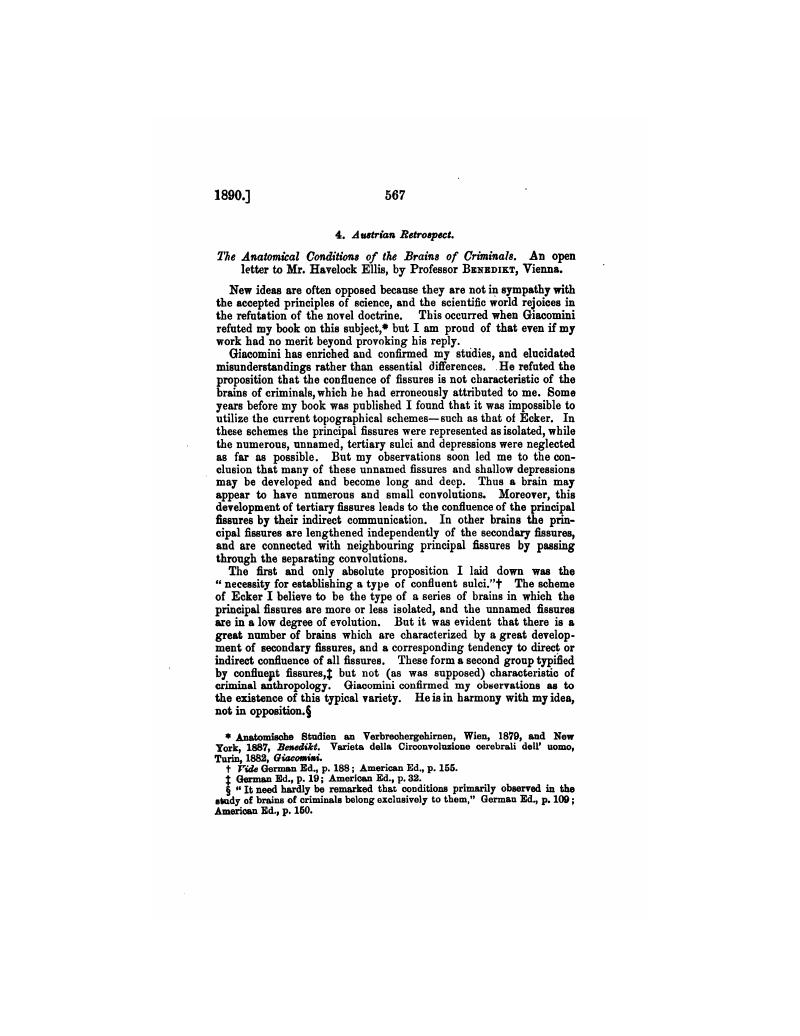No CrossRef data available.
Article contents
4. Austrian Retrospect
Published online by Cambridge University Press: 19 February 2018
Abstract
An abstract is not available for this content so a preview has been provided. Please use the Get access link above for information on how to access this content.

Information
- Type
- Part III.—Psychological Retrospect
- Information
- Copyright
- Copyright © Royal College of Psychiatrists, 1890
References
*
Anatomische Studien an Verbrechergehirnen, Wien, 1879, and New York, 1887, Benedikt. Varieta della Circonvoluzione oerebrali dell' uomo, Turin, 1882, Giacomini.
Google Scholar
§ “It need hardly be remarked that conditions primarily observed in the study of brains of criminals belong exclusively to them,”
German Ed., p. 109; American Ed., p. 150.Google Scholar
*
German Ed., pp. 109—112; American Ed., pp. 155—159, as follows:—“For many of the descriptive details here given, such as are absent in all previous cerebral representations, we are indebted to the special attention which I have bestowed on these brain specimens.” … “It might possibly be supposed that the type which we have deduced from these brains is exclusively a fact of comparative race anatomy, as the normal types of most of these races and clans are unknown, and, moreover, there exists no comparative race-anatomy of the brain,” &c. “For this very reason it—the proposition that the criminals are to be received in an anthropological variety of their species, at least amongst cultured races—should be handled with the greatest prudence, it should not yet serve as a premise; and for the present it should not leave the hands of the expert anatomists.” ….“In matters of fact it must yet be repeatedly proven, and that from many points of view, until it can finally rank as an undoubted addition to human science.” ….“The variety of the conditions which we may expect to meet in the different races will assign to this proposition a little halting place in the history of science, and worthless as well as valuable contributions will, for a time to come, give rise to oscillations and opinions.” …. “He—the criminal with his innate qualities—has the same relation to crime as his next of kin, the epileptic, and his cousin, the insane, have to their encephalopathio conditions.”
Google Scholar
† Zur Frage der Verbrecher Gehirne, Offenes Schreiben au H. Professor Giacomini, “Wiener Med. Presse,”
1883.Google Scholar
*
I have now under study the skull and brain of a very interesting murderer (Schenk). He was a good-looking, fascinating, intelligent man, but unwilling to work. His livelihood was obtained by making love to old female servants, defrauding them of their money, and murdering them in various ways with the assistance of his low associates. On both sides the occipital fissures communicate with this limbic fissure of the middle vasio lobe, while the limbic fissure is connected with the collateral fissure of the occiput.Google Scholar
*
In Schenk's brain, on the left side, the first external pli de passage is not on the surface, and the second is much reduced. On both sides the central fissures are confluent with the first frontal; and on the left side the central fissure is also confluent with the retro-central, which form a true operculum.Google Scholar
† See case 5 (left hemisphere of a forger) in my book.Google Scholar
‡
See case in
“Mittheilungen des Wiener Med. dock,”
1888. “Demonstration eines Verbrechergehirnes.”
Google Scholar


eLetters
No eLetters have been published for this article.